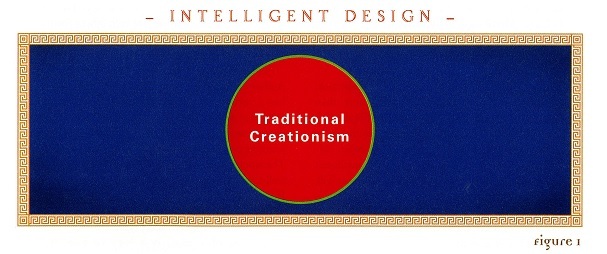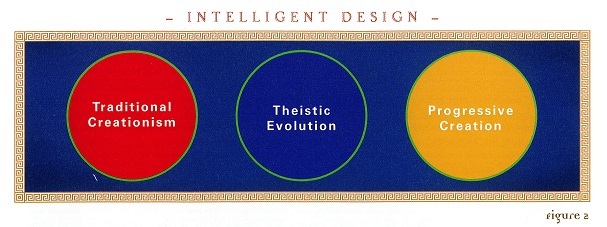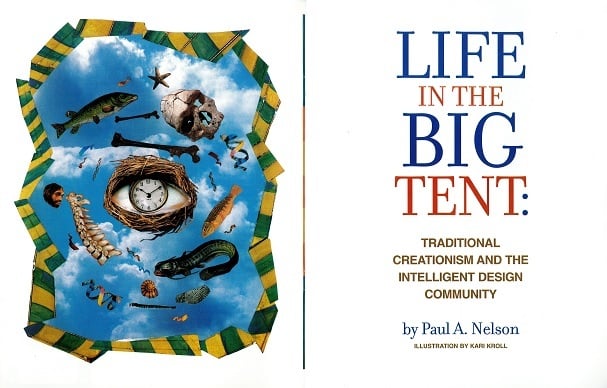This article first appeared in the Christian Research Journal, volume 24, number 4 (2002). For further information about the Christian Research Journal go to: http://www.equip.org
SYNOPSIS
Until recently, the majority of active dissenters from neo-Darwinian (naturalistic) evolution could be classified as “young-earth” (or what I call “traditional”) creationists. Their dissent could be dismissed as motivated by biblical literalism, not scientific evidence. While this criticism of traditional creationists is unfair to the actual content of their views — many prominent creationists are outstanding scientists — the absence of a wider community of dissent from Darwinism hindered the growth of scientific alternatives to the naturalistic theory. Such a wider community now exists in the “intelligent design” (ID) movement.
Within the past decade, the ID community has matured around the insights of UC Berkeley professor Phillip Johnson, whose central insight is that science must be free to seek the truth, wherever it lies. The possibility of design, therefore, cannot be excluded from science. This outlook has deep roots in the history of Western science and is essential to the health of science as a truth-seeking enterprise. Under the canopy of design as an empirical possibility, however, any number of particular theories may also be possible, including traditional creationism, progressive (or “old-earth”) creationism, and theistic evolution. Both scientific and scriptural evidence will have to decide the competition between these theories. The “big tent” of ID provides a setting in which that struggle after truth can occur, and from which the secular culture may be influenced.
The observation was only a pair of sentences near the end of a review, just the sort of point made in passing that a hasty reader might overlook. Those two sentences, however — appearing in the journal Science and written by Yale University biology professor Timothy Goldsmith — reflect a historic shift in the debate over origins, a shift that promises both opportunities and challenges for evangelical Christians.
Goldsmith was reviewing the public broadcasting series Evolution, a program assembled to counter the recent growth of skepticism about naturalistic evolution in the United States. In commenting on the last segment of the program, “What about God?” which surveyed the creation-evolution debate, Goldsmith noted, “My one criticism of this coverage is that it may leave the impression that antievolutionists are all young-earth creationists. Such is not the case; antievolutionists occupy a broad theological spectrum and they are not all Christians.”1
Now, why is this observation significant? The authorities of science have long said “antievolutionists” — meaning those who dissent from Darwin’s theory of the common descent of life via undirected natural causes — are simply Protestant fundamentalists whose literal reading of Genesis cannot allow them to accept the obvious truth of evolution. From the 1960s to the early 1990s, such persons primarily would have occupied the categories of “antievolutionist” or “creationist.” I shall term this group “traditional creationists,” meaning anyone who thinks that God directly created everything in six 24-hour days, several thousand years ago.2
Over the past decade, however, the demographics of dissent from neo-Darwinian evolution have changed dramatically. In some discussions on university campuses or Internet listserves, traditional creationists now find themselves distinctly in the minority among skeptics of neo-Darwinism. Although they have grown accustomed to scorn from evolutionary scientists, traditional creationists may be unhappy to discover that their own allies (other anti-Darwinians) regard them as poor cousins visiting from the trailer park — sincere but somewhat embarrassing folk, whose unsophisticated manners and naíve beliefs should be kept quietly in the background when others are talking about science.
One might say, nevertheless, such is the price of success. What creationists have sought throughout the twentieth century is an open-ended debate about the truth of Darwinian evolution. That debate has now arrived in the emergence of the “intelligent design” (ID) movement. As Goldsmith noted, one can no longer accurately characterize dissenters from Darwinian evolution strictly as “young-earth” creationists. In this article, I shall briefly recount the history of this shift, locating it (in large measure) in the work of the UC Berkeley law professor Phillip Johnson. I then explain that, while it may prove unsettling to many Christians, the growth of a broader debate about evolution and creation can actually be seen as a boon for those struggling to discern the proper relationship between science and faith, how to understand the Book of Genesis, and how to defend the Christian worldview in a hostile secular culture. Life in the “big tent” of the intelligent design community certainly requires a period of acclimation, but Christians — in particular, traditional creationists — should welcome their new ID surroundings.
THE LAW PROFESSOR ON SABBATICAL IN LONDON
Let’s begin with some history. The year 1987 marks a noteworthy turning point in the American debate over the science and philosophy of origins. In that year, a long cultural battle that had begun more than a quarter century earlier (with Henry Morris and John Whitcomb’s classic The Genesis Flood in 1961) appeared to many onlookers to have come decisively to an end when the Edwards v. Aguillard decision of the U.S. Supreme Court declared “creation-science” to be a religious belief. As University of Wisconsin historian Ronald Numbers explains in his recent survey, Darwinism Comes to America, the publication of The Genesis Flood had sparked the rapid growth of “creation-science,” as it came to be called. It emphasized a young earth, a global flood, separately created kinds of animals and plants, and a specially created Adam and Eve as the progenitors of humankind.3 In 1963, the Creation Research Society (CRS) was founded to articulate these ideas. The CRS quickly gathered a membership of hundreds of scientists, and, in 1964, it began to publish a quarterly research journal. In 1970, the CRS brought out the biology textbook Biology: A Search for Order in Complexity in an attempt to provide an alternative “model” for the teaching of biology in public schools. In 1972, Henry Morris left a professorship at the Virginia Polytechnic Institute to establish the Institute for Creation Research (ICR) in San Diego, which, through its publications and lectures, vigorously promoted the “two model” approach.
It was, however, the legislative efforts of creation science supporters to mandate equal time for creation science in state science education that really ignited the national controversy. Alarmed by the passage of “balanced treatment” laws in Arkansas and Louisiana in 1981, a coalition of civil liberties, scientific, and religious groups formed to combat the spread of creationism. In 1982, Federal Judge William Overton declared the Arkansas balanced treatment law unconstitutional in McLean v. Arkansas Board of Education; but it was the 1987 Supreme Court opinion, Edwards v. Aguillard, that seemed to shut the door permanently on creationism (at least as admissible dissent in public school science teaching). Creation science, said the Court, is “the religious belief that a supernatural being created humankind.” The teaching of a particular religious belief in public schools violates the First Amendment, and thus “balanced treatment” laws have no genuine secular purpose.4
The “two-model” approach to the origins controversy was now dead. Shortly after the decision was handed down, the late Stephen Jay Gould, a leader of the anticreation coalition, observed, “We who have fought this battle for so many years were jubilant. The Court, by ruling so broadly and decisively, has ended the legal battle over creationism as a mandated subject in science classrooms.”5
Edwards v. Aguillard seemingly had ended the public debate over origins. A revolution from an unexpected quarter, however, was about to occur. In 1987, Phillip Johnson, a professor of law at the University of California, Berkeley, was taking a year’s sabbatical in London, England. Every day on the walk to his office, he passed a bookshop where Richard Dawkins’s The Blind Watchmaker and Michael Denton’s Evolution, A Theory in Crisis were on sale. Curious, Johnson bought the books and read them through. He noticed immediately that the ostensible issues of Edwards v. Aguillard were not the real issues at all.
The creationists in Louisiana never had a chance. Because of the way “science” was defined in the debate, the very possibility of evidence against Darwinian evolution had been excluded at the outset. Reading the amicus briefs in Edwards v. Aguillard, such as that filed by the National Academy of Sciences (the most prestigious group of scientists in the nation), Johnson discovered that what had been presented as the ground rules of science had tilted the playing field irrevocably in favor of Darwinian evolution. In Darwin on Trial, the influential book that grew out of his 1987 insights, Johnson wrote, “The Academy thus defined ‘science’ in such a way that advocates of supernatural creation may neither argue for their own position nor dispute the claims of the scientific establishment.”6
The key issue, Johnson recognized, was neither the literal truth of Genesis nor the merits of “creation science.” It was whether there could be, even in principle, any evidence against Darwinian evolution or in favor of design by an intelligence. Was science allowed to consider the possibility of intelligent design? Johnson saw that if science were forbidden by its own rules even to look in the direction of intelligent design, the evidence, whatever it might be, would be irrelevant. Any science that is not free to pursue the truth could be only a blind enterprise, unable to see the testimony of nature.
Despite appearances, this was in some ways a far more radical critique than the traditional creationism of the “two-model” approach. Many creationists advocated a philosophy of science according to which any discipline that deals with historical events is not really science, with the same standing as experimental disciplines such as physics or chemistry. ICR biochemist Duane Gish, for instance, argued in 1985 that, by definition, traditional creationism was not science at all: “Creation is, of course, unproven and unprovable and thus cannot be considered as fact. It is not subject to test by the ordinary methods of experimental science — observation and falsification. It thus does not, in a strict sense, even qualify as a scientific theory.”7 Nor does evolution qualify as science, Gish and other traditional creationists hastened to add.
Johnson rejected this philosophical dichotomizing. Definitions of science, he argued, could be contrived to exclude any conclusion we dislike or to include any we favor. It was not a coincidence, after all, that the definition promoted by the ACLU and the National Academy of Sciences placed creationism outside the province of science. We should rather be asking, Johnson urged, a more fundamental question: What do we have reason to think is true?
Darwin on Trial laid out these arguments and provided the philosophical core for a research community that had already begun to form in the 1980s around such books as The Mystery of Life’s Origin.8 In June 1993, Johnson invited several of the (mostly younger) members of that community to a conference at the California beach town of Pajaro Dunes. Present were scientists and philosophers who themselves would later become well known, such as biochemist Michael Behe, author of Darwin’s Black Box (1996); mathematician and philosopher William Dembski, author of The Design Inference (1998) and Intelligent Design (1999); and developmental biologist Jonathan Wells, author of Icons of Evolution (2000). Of the 14 participants at the Pajaro Dunes conference, only three (microbiologist Siegfried Scherer of the Technical University of Munich, paleontologist Kurt Wise of Bryan College, and me) could be seen as traditional creationists. Moreover, theological diversity marked the meeting: in addition to the expected presence of evangelicals, Behe was Roman Catholic; Wells was a member of the Unification Church; and one participant — paleontologist David Raup of the University of Chicago — was an agnostic.
Pajaro Dunes thus became a model for what has come to be known as the “intelligent design movement.” Unlike other science and faith organizations (such as the traditional creationist CRS or the moderate American Scientific Affiliation [ASA]), no statement of faith was required at Pajaro. What united the participants (with the possible exception of Raup) was a deep dissatisfaction with neo-Darwinism and its naturalistic philosophical foundation and an interest in scientifically exploring the possibility of design.
Johnson’s revolution was simplicity itself. Since the middle of the nineteenth century, our scientific understanding of origins, he argued, has been saddled with a particular philosophy — naturalism.9 Now, naturalism might be true, but it might also be false. The wise course of action for science, therefore, is not to assume naturalism’s truth but to let the evidence speak for itself. If someone is interested in discovering the truth and wants to take a fresh look at the evidence, then that person is welcome to join the community. The admission price is minimal: one need only allow for the possibility of design.
GOD’S FREEDOM AND THE LOGIC OF DESIGN
What Johnson had noticed was revolutionary in one respect, but profoundly historical (i.e., deeply rooted) in another. The word “science” in its original sense did not entail naturalism — the doctrine that only natural causes are admissible in an explanation. Instead, “science” referred to knowledge, from the Latin word for “knowledge,” scientia. We know all sorts of things: the atomic number of gold (79), the diploid chromosome number of Homo sapiens (46), and the distance from the earth to the sun (93 million miles). We also know that someone constructed Stonehenge, that e-mail messages have authors, that missing valuables may well have been stolen, and that it is possible that intelligence exists in others besides humans. If we can know, as we surely do, that an intelligence generated the information contained in the lines of the poem “Stopping by the Woods on a Snowy Evening,” then might it be possible that an intelligence composed the original information-rich DNA sequences in organisms? Yes — and in that yes lies the falsity of naturalism as a philosophy of science.
The founders of Western science did not know about DNA, but they certainly knew, as Thoreau famously quipped, that something was afoot when “a trout was in the milk.” It is genuine scientia (knowledge) that a stone will fall to the ground when it is released; but it is also genuine scientia that a letter has an author. It would be absurd to say that only the first — physical regularity — counts as knowledge, whereas the second — intelligent design — does not. Robert Boyle or Isaac Newton would have laughed at such a suggestion.
Newton and Boyle also held a conviction about God’s freedom as author of the world, and here we return to the matter of traditional creationism within the tent of the intelligent design community. In his treatise, A Free Inquiry into the Vulgarly Received Notion of Nature, an argument against the naturalism of his time, Robert Boyle concluded by stressing God’s freedom to create as He pleased: “God is a most free agent, and created the world not out of necessity but voluntarily, having framed it as he pleased and thought fit at the beginning of things, when there was no substance but himself and consequently no creature to which he could be obliged, or by which he could be limited.”10
If the author of the world acted freely, then we will need to discover what He did by enlisting our intellectual labor (including the labor of interpreting the Bible). Johnson saw that allowing for the possibility of design as special divine action (for instance, God creating human beings directly) meant that one must also allow for other possibilities, such as God electing, if He so chose, to use an evolutionary process that was itself designed. “I believe,” Johnson wrote, “that a God exists who could create out of nothing if He wanted to do so, but He might have chosen to work through a natural evolutionary process instead.”11 God could have created everything in six 24-hour days — or not. The fundamental point is to allow for the possibility of design. The scientific narrative of design — when God acted, and how — might capture any number of competing theories. We would have to see. Such narrative would need to be discovered, and an answer might be a long, and possibly painful, time in coming.
This point can be expressed by a pair of diagrams (Figure 1 and Figure 2):


Consider the first diagram. If traditional creationism (the circle) is true, then so too, by logical implication, is intelligent design (the box). Any specially created world would necessarily be a designed world, but the reverse is not the case. Because of God’s freedom to create as He pleases, design might be true while traditional creationism is false. A second diagram, where other theories of God’s action (e.g., progressive or “old earth” creation) are possible within the larger box of design, illustrates this point.
Some prominent traditional creationists are unhappy with what they perceive to be the dangerously wide content of ID. “This approach, even if well-meaning and effectively articulated,” writes ICR President Emeritus Henry Morris, “will not work! It has often been tried in the past and has failed, and it will fail today.”12 The inclusion of progressive creation and theistic evolution as design possibilities (Figure 2, above) is, in Morris’s view, a weakness, not a strength, of the ID community.13 Morris argues that pantheism and New Age ideas might also fit comfortably within the big tent of design, a sure sign that the ID community has been much too broadly defined to be of any value for Christians.
Other Christian critics have taken just the opposite tack, stressing that the ID community is little more than “creationism in designer clothing.” The big tent is an illusion, erected for public relations purposes, and under the fancy inclusive language one finds (as before) the same old-fashioned interventionist creationism. “Does the intelligent design movement,” asks one such critic, Howard Van Till, “have a chance? From my perspective, No. Not until it is willing to place its theological and philosophical cards on the table so that its foundational presuppositions may be opened to public scrutiny and evaluation.”14
THE PROMISE OF DESIGN
The attentive reader will have noticed that both of these critics of ID have settled views on which scientific narrative of design is true: six-day, young earth creation for Morris; the “fully-gifted” evolutionary scenario for Van Till.15 A greater contrast in scientific perspectives among Christians is hard to imagine. Neither Morris nor Van Till has much, or any, interest in talking to his counterpart, whom each sees as hopelessly in error and doing severe damage to the cause of Christianity.
Despite this, both Morris and Van Till affirm the First Article of the Apostles’ Creed: “I believe in God the Father Almighty, maker of heaven and earth.” A cynic might say, given the very different meanings Morris and Van Till attach to those 12 words, the intersection of their joint affirmations is empty, but the cynic would be wrong. More than enough content in the First Article exists to distinguish its affirmation from the naturalism held by most scientists. However much Morris and Van Till may despise each other’s positions, both believe God designed the universe and brought it into existence for His pleasure and purposes.
That theological commonality — namely, God is the Author of the Universe, in whatever way He chose to act — has a secular counterpart in the philosophy of science: intelligent design is possible.16 Now, the mere possibility of design may seem a modest claim, but for the majority of the scientific community it is a deeply radical breach of the rules. The whole point of methodological naturalism is to keep ID well outside of the province of science. Everything within the ID box (see Figure 2) offends the philosophical naturalist. If some members of the big tent of design (e.g., theistic evolutionists) appear acceptable to the naturalistic mainstream of science, it is only because of political expediency. If theistic evolutionists were the only people to occupy the ID position, however, they would not be spared the scorn now directed mainly at traditional creationists. At the moment, the latter simply present an easier target.
“But theistic evolution is still an incoherent theory for any orthodox Christian,” the reader may protest. Yes, very likely that’s the case, I want to say (as a traditional creationist), but does that mean I have nothing to learn from my theistic evolutionary brother or sister? Not at all. Every position within the ID tent faces real scientific and theological difficulties. In a fair competition between design simpliciter and naturalism, design wins hands down; but it would be the height of blind pride to say that any particular design theory has taken the day, solved its outstanding puzzles, and now needs to sweep away only the last bits of confusion residing in the minds of the unpersuaded.
Do traditional creationists have a geological or geophysical theory capable of explaining all radiometric data? No — which is exactly the reason the ICR and CRS are pouring resources into the problem.17 Do progressive (or “old earth”) creationists have a theologically satisfactory understanding of the origin of so-called “natural evil” (e.g., parasites, many of which have complex life cycles that are amazing examples of intricate design)? No — and many progressive creationists even seem unaware that such problems exist. Have theistic evolutionists sorted out the grave explanatory hurdles facing current theories of evolution to which they wish to attach God as author? No — and over the past few decades, the shortcomings of evolutionary theories have grown much worse. Do evangelical exegetes agree on how best to interpret Genesis 1–11? No — and the controversies that have raged for nearly two centuries, if not longer, show no signs of abating.18
In short, humility on all sides is in order — but so is joyful confidence. What is the fastest way for any design theorist to discover what’s wrong with his or her theory of origins and how that theory might be improved? Talk to someone who shares the foundational design premise, but disagrees about the details. “As iron sharpens iron, so one man sharpens another” (Prov. 27:17). The promise of the big tent of ID is to provide a setting where Christians (and others) may disagree amicably, and fruitfully, about how best to understand the natural world, as well as Scripture. In a recent article on the interpretation of Genesis 1–11, theologian R. C. Sproul wrote that the issue is “both neglected to our peril and elevated to a degree of importance it does not deserve.”19 The issue is often elevated too high, said Sproul, because Christians historically have affirmed not any particular theory of earth history, but rather God’s authorship of the universe: “I believe in God the Father Almighty, maker of heaven and earth.” The issue cannot be neglected, however, because the Bible does speak unequivocally of creation and the evidence of God’s authorship in nature.
As painful as it may sometimes be, Christians must continue the struggle to understand the relationship between science and faith. The existence of a research community where design is taken seriously and where all inquirers are welcome means that the ongoing struggle need not be solitary. It may even turn out to be a tremendous adventure.
Notes
- Timothy Goldsmith, “Everyday Impacts of a Most Influential Theory,” Science, 21 September 2001, 2209–10.
- The usual term for this group is “young-earth creationists.” John Mark Reynolds and I have argued that “young-earth” is a misleading adjective. “If you are asked to give your age on a legal form,” we wrote, “you do not write ‘old,’ ‘young,’ ‘recent,’ or any other relative term; rather, you give an exact number. The world is precisely as old or as young as it actually is. Young-earth creation is thus a confusing misnomer, seeming to imply that the earth or universe are young relative to some unspecified (‘old’) reference point.” (Nelson and Reynolds, “Young Earth Creationism,” in Three Views on Creation and Evolution, ed. J. P. Moreland and Reynolds, [Grand Rapids: Zondervan, 1999], 41.)
- Ronald Numbers, Darwinism Comes to America (Cambridge, MA: Harvard University Press, 1998), 4–7.
- Edwin W. Edwards, etc., et al, Appellants, v. Don Aguillard et al., Full Text of Opinions, The United States Law Week, 55 LW 4860.
- Stephen Jay Gould, “The Verdict on Creationism,” the New York Times Magazine, 19 July 1987, 32.
- Phillip E. Johnson, Darwin on Trial (Downers Grove, IL: InterVarsity Press, 1993), 8.
- Duane Gish, Evolution: The Challenge of the Fossil Record (El Cajon, CA: Master Books, 1985), 19.
- Charles Thaxton, Walter Bradley, and Roger Olsen, The Mystery of Life’s Origin (New York: Philosophical Library, 1984). Mystery was not only a powerful and analytically deep critique of naturalistic theories of the origin of life, but it also contained suggestions for a revival of the neglected hypothesis of design in science proper. Like several others, I first learned about Phillip Johnson at a June 1988 conference on the origin of information content in DNA, organized by Charles Thaxton. Stephen Meyer, at the time a graduate student at Cambridge University, attended Thaxton’s conference, bringing with him a manuscript from (as Meyer put it with a grin) “this wild lawyer I met in the UK.” I can still recall my excitement at the conference when I read through the manuscript, which later became Darwin on Trial.
- It is customary for defenders of naturalism to distinguish between “philosophical” and “methodological” naturalism. The former, they say, is indeed a philosophy that excludes theism (and thus does not belong in any philosophically disinterested science), whereas the latter is simply a neutral rule needed to ensure that science sticks to what it can actually observe and test. If design is an empirical possibility, however, methodological naturalism is anything but a neutral rule. “One may employ only natural causes in scientific explanation” — a good short formulation of methodological naturalism — guarantees, if design is actually the case (true), that science will either (a) come up with false theories, or (b) search fruitlessly for nonexistent natural explanations. In both instances, truth will not be served. As a philosophy of science, therefore, methodological naturalism is nothing but rubbish. To see this point made more calmly, but with insightful rigor, the reader should consult Del Ratzsch’s Nature, Design, and Science: The Status of Design in Natural Science (Albany, NY: State University of New York Press, 2001).
- Robert Boyle, A Free Inquiry into the Vulgarly Received Notion of Nature, ed. Edward B. Davis and Michael Hunter, Cambridge Texts in the History of Philosophy (Cambridge: Cambridge University Press, 1996), 160.
- Johnson, Darwin on Trial, 14.
- Henry Morris, “Design Is Not Enough!” http://www.icr.org/pubs/btg-a/btg-127a.htm.
- By “theistic evolution” I mean any theory of evolution where the adjective “theistic” makes an explanatory difference or genuinely affects the content of biological science. I do not include in the design tent those accounts of theistic evolution where “theistic” is an empirically empty modifier. Like “chocolate ice cream” or “cold water,” the adjective “theistic” should have meaningful, detectable content.
- Howard J. Van Till, “Does ‘Intelligent Design’ Have a Chance?” Zygon 34 (1999): 675.
- By “fully gifted,” Van Till means that from its inception the universe was endowed with every causal capacity needed to bring forth (in time) all objects, both nonliving and living, now observed; thus, “there are no gaps (caused by missing capabilities) in the formational economy of the universe that had to be bridged by episodes of extranatural assembly, most commonly envisioned as form-imposing acts of divine intervention.” See ibid., 674.
- I have argued that Van Till’s “fully-gifted” scenario has discernable empirical content, making it a design theory in the broad sense (see “Is ‘Intelligent Design’ Unavoidable — Even by Howard Van Till? A Response,” Zygon 34 (1999): 677–82. In personal communication, Van Till has indicated some unhappiness with this reading of his work, but he has not explained in any detail where I have understood him incorrectly. While waiting for clarification, then, I prefer my understanding of his position as making more sense than any (unarticulated) alternative.
- See Radioisotopes and the Age of the Earth: A Young-Earth Creationist Research Initiative, ed. Larry Vardiman, Andrew A. Snelling, and Eugene F. Chaffin (El Cajon, CA, and St. Joseph, MO: Institute for Creation Research and Creation Research Society, 2000).
- David Hagopian, ed., The Genesis Debate (Mission Viejo, CA: Crux Press, 2000).
- R. C. Sproul, “The Peaceable Kingdom,” Tabletalk, July 2001, 7.










